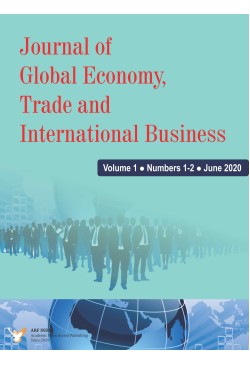MAKE MOST OF THE KNOWLEDGE NETWORK, JOIN ACADEMIC RESEARCH FOUNDATION
Table of Content :-Journal of Global Economy, Trade and International Business, Vol:2, Issue:2, Year:2022
Consumer Expenditure Structure in Rural Bihar: Analysis based on Extended Linear Expenditure System
BY : Jitendra Kumar Sinha
Journal of Global Economy, Trade and International Business, Year: 2022, Vol.2 (2), PP.107-122
Received: 13 February 2022 | Revised: 30 April 2022 | Accepted : 10 July 2022 | Publication: 10 December 2022
Doi No.: https://doi.org/10.47509/JGETIB.2022.v02i02.01
The study has analyzed the consumer demand and expenditure structure of household consumption data using the Extended Linear Expenditure System Model. Budget shares and expenditure elasticities were estimated for consumption categories allowing for a comparison of expenditure elasticities between the two seasons. Expenditure elasticities for consumer expendables, durables, and transport were highly elastic, while expenditure elasticities for the aggregate food categories were negative in October 2019 and highly inelastic in March 2020. Tradable and non-tradable nonfarm goods are highly expenditure elastic. Increased expenditure on nontradable goods and services may stimulate local production, thus creating new employment and enterprise opportunities. The increased expenditure on tradable goods represents a leakage of income from the local economy. The results indicate that an increase in farm incomes has the potential to stimulate economic growth through the stimulation of increased local production of non-farm goods and services. Increased income will also result in increased expenditure on goods not locally produced, which means leakage of income from the local economy. Increased production is limited by factors such as insecure tenure and cash flow problems that are amplified by high transaction costs associated with obtaining credit. Better access to credit would improve cash flow problems somewhat, but transaction costs need to be lowered. Demand-led growth needs to be strengthened with the production of goods not currently produced. Processing raw food materials into more convenient items would encourage increased local expenditure with increased income. The diversification into non-farm activities requires investment and poses a risk. Insecure tenure creates a disincentive to investment. Public policy should focus on alleviating tenure security and institutional infrastructure to strengthen the potential for demand-led growth.
Keywords: Consumer, Elasticity, Price, Expenditure, Demand.
JEL Classification: D12; R2; R5; O2.
JEL Classification: D12; R2; R5; O2.
Jitendra Kumar Sinha (2022). Consumer Expenditure Structure in Rural Bihar: Analysis based on Extended Linear Expenditure System. Journal of Global Economy, Trade and International Business. 2(2), 107-122. https://DOI:10.47509/JGETIB.2022.v02i02.01
Exchange Rate Dichotomy: Demand versus Supply Side Dominance
BY : Sajawal Khan and Muhammad Ejaz
Journal of Global Economy, Trade and International Business, Year: 2022, Vol.2 (2), PP.123-149
Received: 13 October 2022 | Revised: 11 November 2022 | Accepted : 15 November 2022 | Publication: 10 December 2022
Doi No.: https://doi.org/10.47509/JGETIB.2022.v02i02.02
Changes in exchange rate have profound effects on economic activity in an economy. Generally, appreciation of domestic currency is considered contractionary, while a depreciation expansionary. However, depreciation can be contractionary too-hence the term Exchange Rate Dichotomy for countries with high share of imported capital.
Using cross country analysis of 97 economies over the period, 2003- 2017, we show that this indeed happens as supply side effects overwhelm the effects on demand side for a group of countries dependent highly on imported capital (G2) than the group with lower share of imported capital to total investment (G1). Impulse Responses obtained from SVAR and DSGE models show that depreciation in G2 countries has result in lower exports growth and higher inflation for longer durations compared to export growth and inflation in G1 thus indicating that supply side dominates the demand side effects in G2.
The evidence shows that overemphasis on adjustment in exchange rate - especially enforced around program designs of Breton wood institutions - may not be the panacea. Instead, the policy makers must focus on reforms aimed at enhancing the productive capacity of an economy. This, of course, must be achieved without prejudice to the principles and mechanisms needed for a market-based adjustment of exchange rate.
Sajawal Khan & Muhammad Ejaz (2022). Exchange Rate Dichotomy: Demand versus Supply Side Dominance. Journal of Global Economy, Trade and International Business. 2(2), 123-149. https://DOI:10.47509/JGETIB.2022.v02i02.02
What Can We Theoretically Know about Uncertainity Shocks?
BY : Séverine MENGUY
Journal of Global Economy, Trade and International Business, Year: 2022, Vol.2 (2), PP.151-177
Received: 06 August 2022 | Revised: 26 October 2022 | Accepted : 18 November 2022 | Publication: 10 December 2022
Doi No.: https://doi.org/10.47509/JGETIB.2022.v02i02.03
This paper studies the consequences on various economic and prices variables of an uncertainty shock on the preferences of households (demand shock) or on labor productivity (supply shock). The main results of our theoretical model are then as follows. A demand shock on the preferences of the representative consumer /household increases uncertainty about the future and precautionary saving; this implies recessionary tensions. In case of such a negative demand shock, prices (deflation), real and nominal wages decrease, whereas the markup over labor marginal costs increases. A negative supply shock on labor productivity is also recessionary on global economic activity: it implies a decrease of public expenditure and of private consumption. However, a higher volume of labor force must then be employed to compensate for its weaker productivity. Besides, the nominal and the real wage, the markups over labor and capital marginal costs all decrease, in a background of moderate inflationary tensions. Furthermore, the main effect of uncertainty per se and of the variance of shocks would be to increase the potential variance of the public debt level, which would be much more difficult to control.
Keywords: uncertainty shocks, households' preferences, labor productivity
JEL Classification Codes: E27, E32, E60
Séverine MENGUY (2022). What Can We Theoretically Know about Uncertainity Shocks? Journal of Global Economy, Trade and International Business. 2(2), 151-177. https://DOI: 10.47509/JGETIB.2022.v02i02.03
